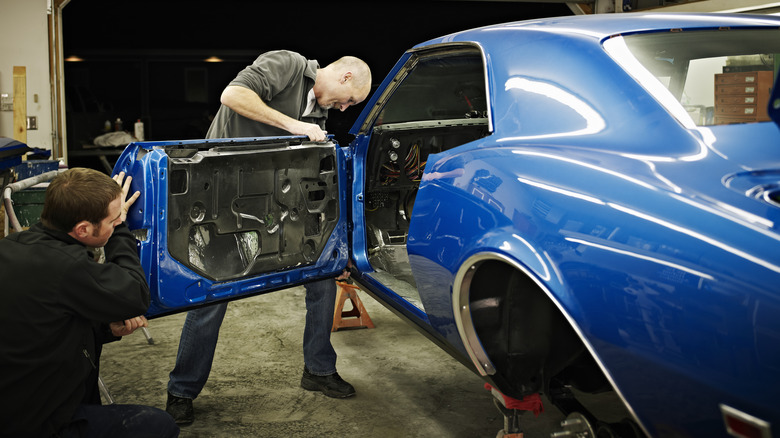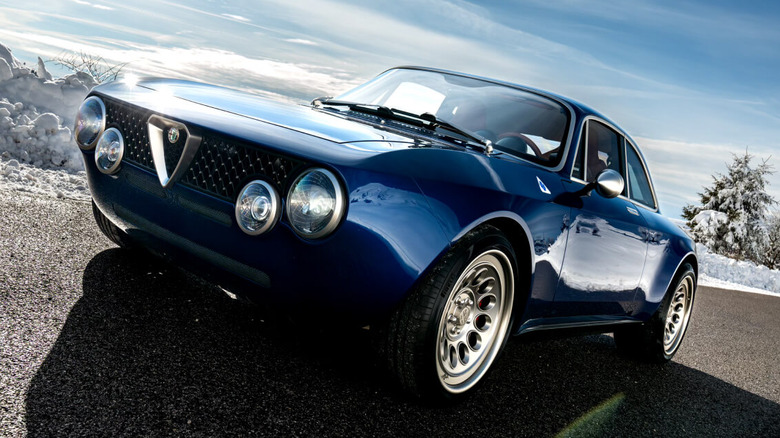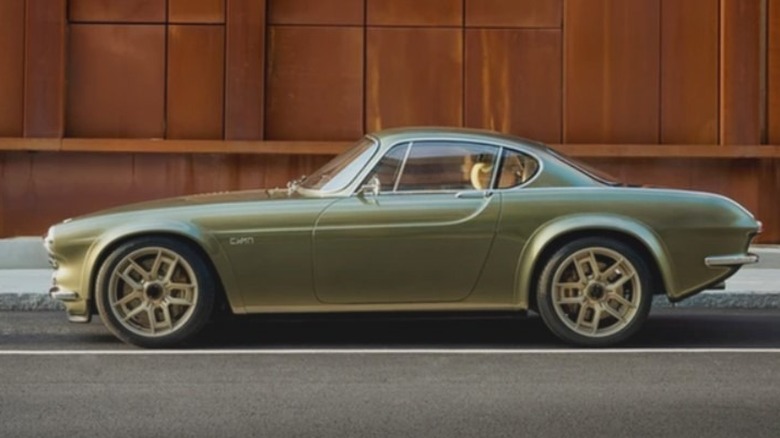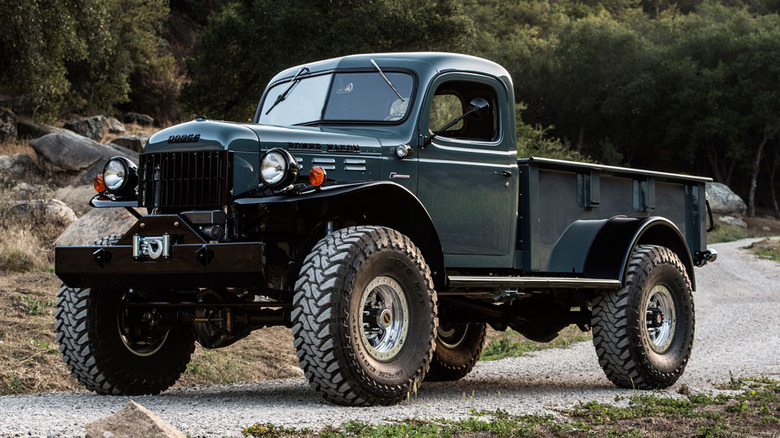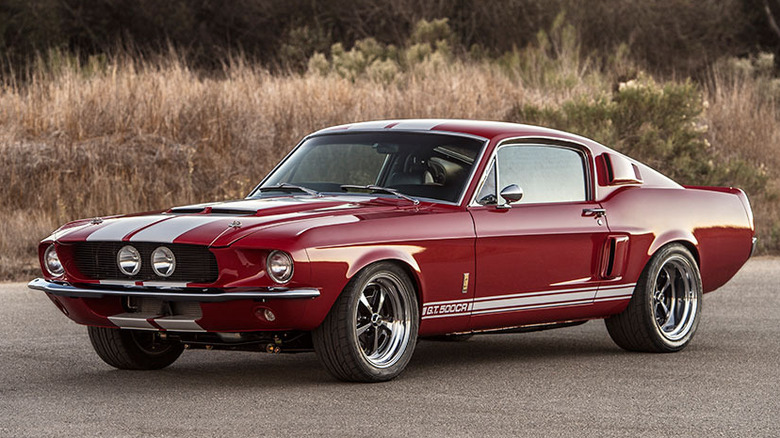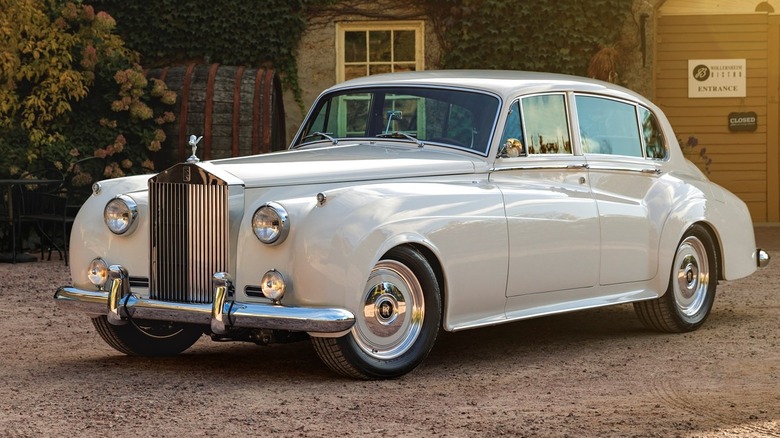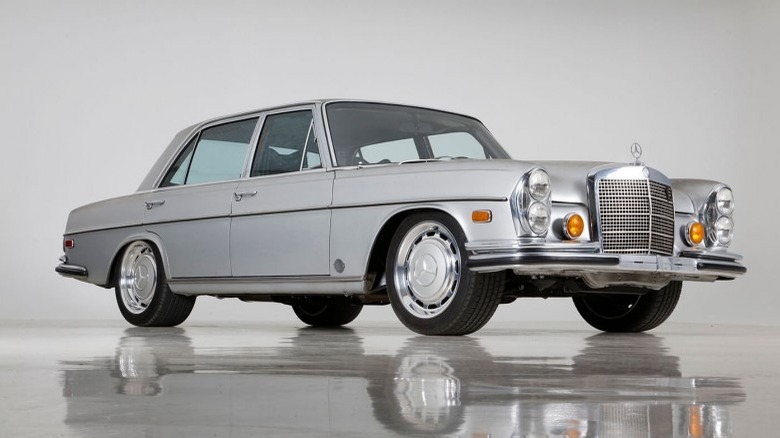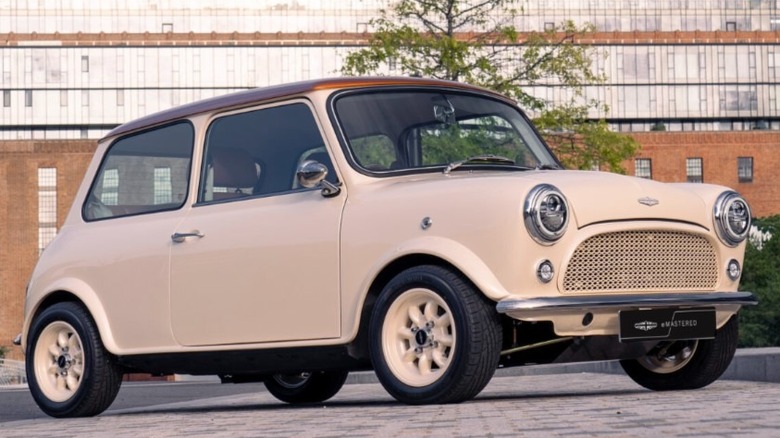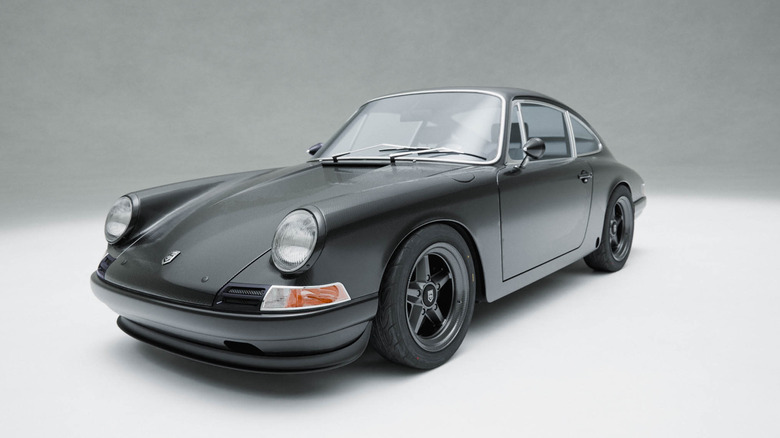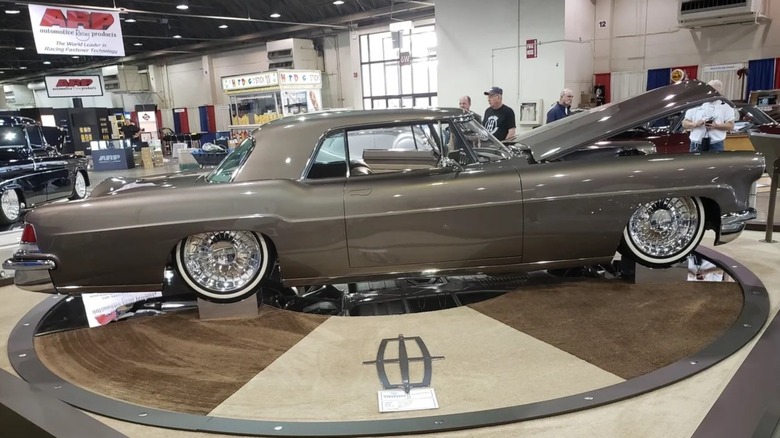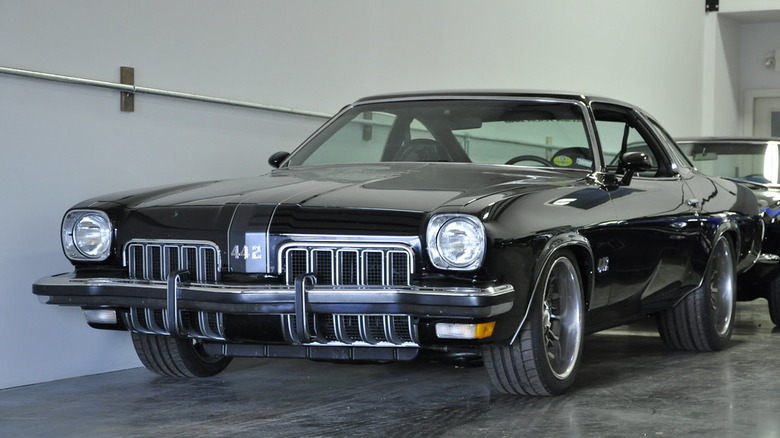10 Of The Coolest Restomods Ever Built
Amateur and professional mechanics have enjoyed bringing old cars back to life for as long as there have been old cars. There are many reasons to restore an old car. For the mechanically inclined, the process can be a matter of practicality. Building a beat-up vehicle into a reliable daily driver can be less expensive than purchasing a new car. Restoring a historically, aesthetically, or personally significant vehicle can also just be worthwhile and satisfying for car lovers.
However, with the speed at which automakers have improved their offerings, antique vehicles often don't live up to modern drivers' performance or comfort standards. Since the 1980s, a growing trend in the car world has been to restore not as it was when it was new, but reimagined as it could be. Restomodding, as the trend is called, is a portmanteau that indicates a restored car that has been modified with modern equipment.
One way to look at restomodding is as a combination of the best of both worlds — a vintage vehicle with modern amenities. These upgrades include anything from brake systems to engines, suspension, framework, body modification, and even internal comforts such as sound or safety systems. Restomodders are beholden more to their personal vision than to the rules of a full restoration, which can result in anything from radical diversions from the manufacturer's original product, gorgeous near-restorations, or artistic masterpieces inspired by the builder's vision. As car lovers, we take a look at 10 of the coolest restomods ever built
Totem Automobili Alfa Romeo Totem GT
The Alfa Romeo Giulia of the 1960s and 1970s probably wouldn't necessarily be the first thing to come to mind when you're considering a restomod. Unless you're Totem Automobili.
The Theseus Paradox asks whether a ship with every component replaced over time is still the same. With how gorgeous the Totem GT turned, we're not sure we care.
There is not a scrap of the original Alfa Romeo GTA in the Totem GT Super. Instead, Totem created a carbon fiber monocoque and filled it with in-house components. The heart of the matter is a bespoke 2.8-liter twin-turbo V6 that sends around 600 horsepower to the rear wheels via a six-speed manual transmission employing an oh-so-Italian gated shifter. Brembo GT-M brakes bring the affair to a safe stop.
Beyond that, the buyer has many options, including paint, trim, tires, rims, interior finish, infotainment system, ABS, engine bay finish, and more. That's right — the Totem GT isn't a one-off build for the car show circuit: You can build one yourself. If you have a half-million Euros lying around, that is. The builders have imbued the car with every ounce of Italian style and grace. The fact that its performance borders on supercar territory is just the powdered sugar on the cannoli.
Volvo P1800 Cyan
There is no doubt that Cyan's whole ethos is rooted in visual design. From its obsidian cube headquarters to the beautiful blue hue of its cars, achieving the right look is a core part of what makes the company tick. That focus is a big part of why the Volvo P1800 Cyan is one of our favorite restomods.
Cyan is a formidable race team at its core, and actively participates in the Touring Car Racing (TCR) series. This racing expertise is evident in its approach to modding factory vehicles, with a strong focus on building a grand tourer that prioritizes driver comfort. It stripped down the body and rebuilt it with reinforced steel, replacing almost everything with high-quality components. The interior is a prime example of this, tailored to the customer's preferences, while retaining the classic 1960s style.
Under the hood, a 2.0-liter turbocharged four-cylinder is mated to a five-speed Holinger gearbox. Depending on the tuning, the entire affair will make between 350 and 420 hp.
The original P1800 was introduced in 1961 as a GT coupe with a 1.8-liter engine. Even the earliest versions are easy on the eyes — a far cry from the boxy sedans we grew used to seeing from Volvo. Unlike Totem, Cyan starts with an original specimen and consults the customer to build it into the restomod of the gods over 12 to 15 months.
Legacy Classic Trucks Dodge Power Wagon
Stepping about as far away from elegant European coupes as possible, we land in Jackson Hole, Wyoming, to check out one of the coolest vintage truck restomods we've ever seen. Legacy Classic Trucks starts with a Dodge Power Wagon — America's first 4WD truck — strips it down to the frame, reinforces it for strength, and goes from there.
Buyers can choose from four engine choices: a 6.2-liter Chevrolet LS3 or LSA, a 6.7-liter Chrysler 108 for that authentic Mopar heart, or a 3.9-liter Cummins Turbo-Diesel. The $360,000 starting price may make you think twice about using it to pull tree stumps, but it could. With options that include a positraction rear end, an up to 20,000-pound winch, and three rear axles to choose from, Legacy keeps the power in Power Wagon.
And it's not only about utility here. The interior of the Power Wagon gets just as much attention as the drive train, including air conditioning, modern amenities like locking doors and power windows, backlit gauges, an Alpine stereo, and custom upholstery. It's the big, bad, American truck we never knew we wanted.
Legacy founder Winslow Bent doesn't just build Power Wagons. He also gives vintage Jeep Wranglers a similar five-star treatment.
Classic Recreations' Shelby GT500CR Classic
No list of restomods is complete without one of the most beloved and lusted-after American muscle cars of all time, this one from Classic Recreations. The Shelby GT500 has been on the minds of car lovers since well before fellow American icon Nic Cage stole it in "Gone in 60 seconds."
In the heyday of the 1960s, muscle cars represented some of the best-performing cars available. Unfortunately, a good number of the best muscle cars of the era can be outpaced by a Toyota Corolla today. Not so for restomods from Classic Recreations, which seeks to put vintage muscle back on the pedestal where it belongs.
Classic Restorations builds a 1967-68 Shelby GT500 from the ground up as a lightweight, carbon fiber reimagining of the classic. Customers can choose from a 427 cubic inch crate engine or a 302 cubic inch Coyote motor making 540 and 490 hp, respectively. Those power numbers are more than respectable already, but with Eleanor's carbon fiber resurrection taking 600 pounds off the original curb weight, we're talking about one fast car. With an optional automatic transmission or Tremec six-speed, four-piston Wilwood disc brakes pull it to a stop.
The interior includes five-point seatbelts, air conditioning, a Pioneer stereo system, and vintage gauges. There's something timeless about the beauty of the '60s pony car, and Classic does an excellent job of bringing all of the right pieces back to life.
Ring Brothers 1961 Rolls Royce Silver Cloud
One of the nicest things about restomods is that they don't have to adhere strictly to convention. Car building is as much art as science, and Mike and Jim Ring are as much artists as engineers. As a company, Ring Brothers is all over the map, restomodding everything from classic Chargers to K5 Blazers, but its dabbling in the world of vintage English luxury is what caught our attention.
From the outside, the 1961 Silver Cloud looks like an excellent straight restoration to the casual eye. The Rolls' body panels are mainly untouched, but beneath the surface lurks a few surprises. To begin with, a supercharged GM LT4 6.2-liter V8 lies under the hood. That sound you just heard was Roll Royce snobs all over the country dropping dead.
Original equipment or not, the new engine ups the horsepower from the original Cloud's 185 to a whopping 640. As far as we're concerned, this tame-looking (but beautiful) Rolls is a genuine sleeper.
The interior gets the full treatment, including a Starlight Headliner that didn't begin appearing in Rolls Royce cars until 2007. That's practically the definition of restomod: the old and new reimagined into something wondrous. A hydro-dipped carbon fiber dash, red-leather upholstery, and custom setting complete the rest. Unlike some of the other cars on this list, the Silver Cloud is not available to anyone who wants it. Like many Ring Brothers' projects, it's a one-of-a-kind construction.
Icon 1971 Mercedes Benz 300 SEL
Speaking of subtle reimaginings of European classics, Icon has entered this 1971 Mercedes-Bens SEL into the lexicon of restomodding. It may not look like much at first glance (unless you're into classic Benzes), but Icon has been building thought-provoking restomods since founders Jonathan and Jamie Ward had a hand in developing Toyota's now-discontinued FJ Cruiser.
Unlike some of Los Angeles-based company's other builds, the 300 SEL is understated. With a one-of-a-kind Art Morrison chassis, Brembo brakes tucked behind custom wheels, a supercharged 6.2 liter LS9 making over 550 horsepower, and a custom but classic interior with carbon fiber seat heaters, this restomod might actually be pretty close to what Mercedes might have produced if the technology was available in 1971 (minus the GM engine, of course.)
From a distance, the Benz looks like any other aging Mercedes, a gracious lady well past her prime. But pull up next to it at a stoplight, and it'll blow the doors off your jalopy with a press of the accelerator. Silver, sleek, and subtle, it's not exactly what we've come to expect from a builder most associated with Ford Broncos, but it has a certain je ne sais quoi we can't deny.
David Brown Automotive eMastered Mini
The best restomods spring out of originals that already stand the test of time. Few cars have endured like the Mini Cooper. First introduced in 1957 in a post-war England grappling with its falling place in the geopolitical hierarchy and the fuel supply issues of the Suez Crisis, the Mini was designed as a gas-sipping economy car. It proved to be so much more than that.
Reinvigorated by BMW in 2000, the Mini has captured the hearts and minds of car lovers, including David Brown. With a passion for cars and a devotion to English engineering, the British automaker founded David Brown Automotive in 2013 to bring new life to English vehicles like the Mini. And if restomodding mixes the old and the new, his eMastered classic Mini is a perfect example.
Powered by a Zonic 70 electric motor, the diminutive restomod has a 110-mile range, a maximum speed of 92 mph, and an 8.5-second 0 to 62 mph time. It is not a performance vehicle, but what could be more faithful to the original Mini's spirit?
The Morris Company that built the original would undoubtedly appreciate Brown's attention to detail. The paint is hand-applied, the interior hand-trimmed with a wide array of leather and fabric choices, and the styling is quintessentially British. An updated infotainment system and modern amenities remind drivers that this is not your average Mini, as well.
Kamm Porsche 912C
The Porsche 912 is not usually at the forefront of conversations about the best Porsches, but Kamm has built a fantastic restomod around it. Porsche introduced the 911 to replace the vaunted 356, but it proved expensive. The company found a middle ground by putting the same flat-four, air-cooled engine into a 911, and the 912 was born. Built between 1965 and 1969, Kamm brings it back to life with its 912c restomod.
Unlike the builders on this list that build a restomod from scratch based on original dimensions, Kamm starts with a donor car, letting buyers choose between a semi- or full-carbon fiber reconstruction. Kamm builds from the ground up after replacing steel parts with carbon fiber and reinforcing the body and chassis. Like Porsche used in the original, Kamm employs a 2.0-liter air-cooled engine with about 190 horsepower. It is not overly powerful by today's standards, but at 1,653 pounds, it doesn't take much to wind up the 912c.
Though Kamm positions the 912c as a road racing machine, the company doesn't ignore the amenities. Buyer preference can tilt the spectrum from a track-focused experience to a more comfortable road car.
With the 912c Kamm does a masterful job keeping the original spirit of the Porsche alive. It is light, fun to throw around a track, and, honestly, downright gorgeous. The fact that it's a bit of a sleeper pick to go with the 912 over a more famous or popular model appeals to our sense of contrarianism.
Havasu Speed's Cashmere Lincoln
If any vehicle of yesteryear is worthy of the restomod treatment, it is the Continental Mark II. Once the most expensive vehicle built in America, it sold for $10,561 fully loaded (including a $595 air conditioning option), or nearly $120,000 in today's money. Ford spared no expense in building the Mark II, either. Hand-made and detailed, every model produced allegedly lost the company $1,000.
The artists at Havasu Speed have brought the royal Continental back to life with this fantastic build. Though it could likely fit a much larger engine, Havasu opted to keep it in the family with a Ford 5.0-liter Coyote V8 nestled in the engine bay. The leather interior by Roy Mangus helps make it clear why this Lincoln earned the nickname Cashmere with its suppleness and fine details.
The Lincoln was already big at an incredible 18 feet long, but Havasus made it look low and lean by chopping 2 inches off its roof. The entire thing screams elegance. It is so smooth it looks like it should be dripping at the top of a waffle cone. A daily driver, this thing is not.
Schwartz Performance 1973 Oldsmobile 442
Though the Oldsmobile 442 is firmly ensconced in the annals of muscle car history, by 1973, the gas crisis and government regulation had already ruined the party for many. The 1973 Oldsmobile 442 is not usually associated with the most gorgeous vehicles of the muscle car era, but in the hands of Schwartz Performance, this restomod shines.
According to Schwartz, a customer came to them with this 442 and requested to redo everything but the paint. Oh, and more power would be nice. They took that request seriously. The Olds got a complete teardown and rebuild, including bodywork, adding some custom flair that blends perfectly with the original design, improving everything odd about the styling, and accenting everything right.
As for the power, Schwartz added a 700 hp GM LSA V8 with a hundred shot of nitrous. Hopefully, that'll help the old boat pass faster on the highway. The revamped 442 is greater than the sum of its parts, a lean and definitively mean road machine that takes, to put it kindly, a less-than-aesthetically pleasing muscle car and injects it with style.
